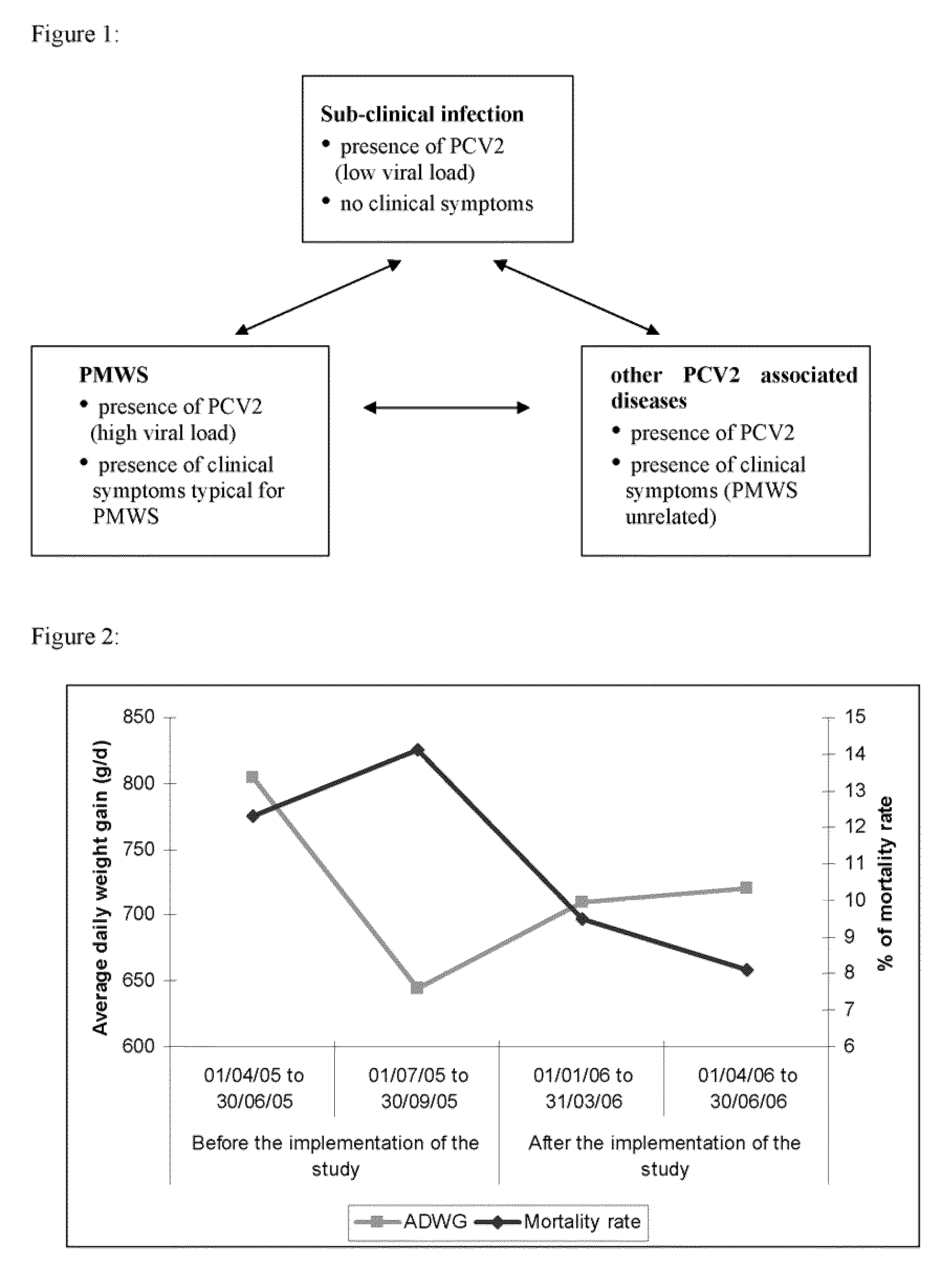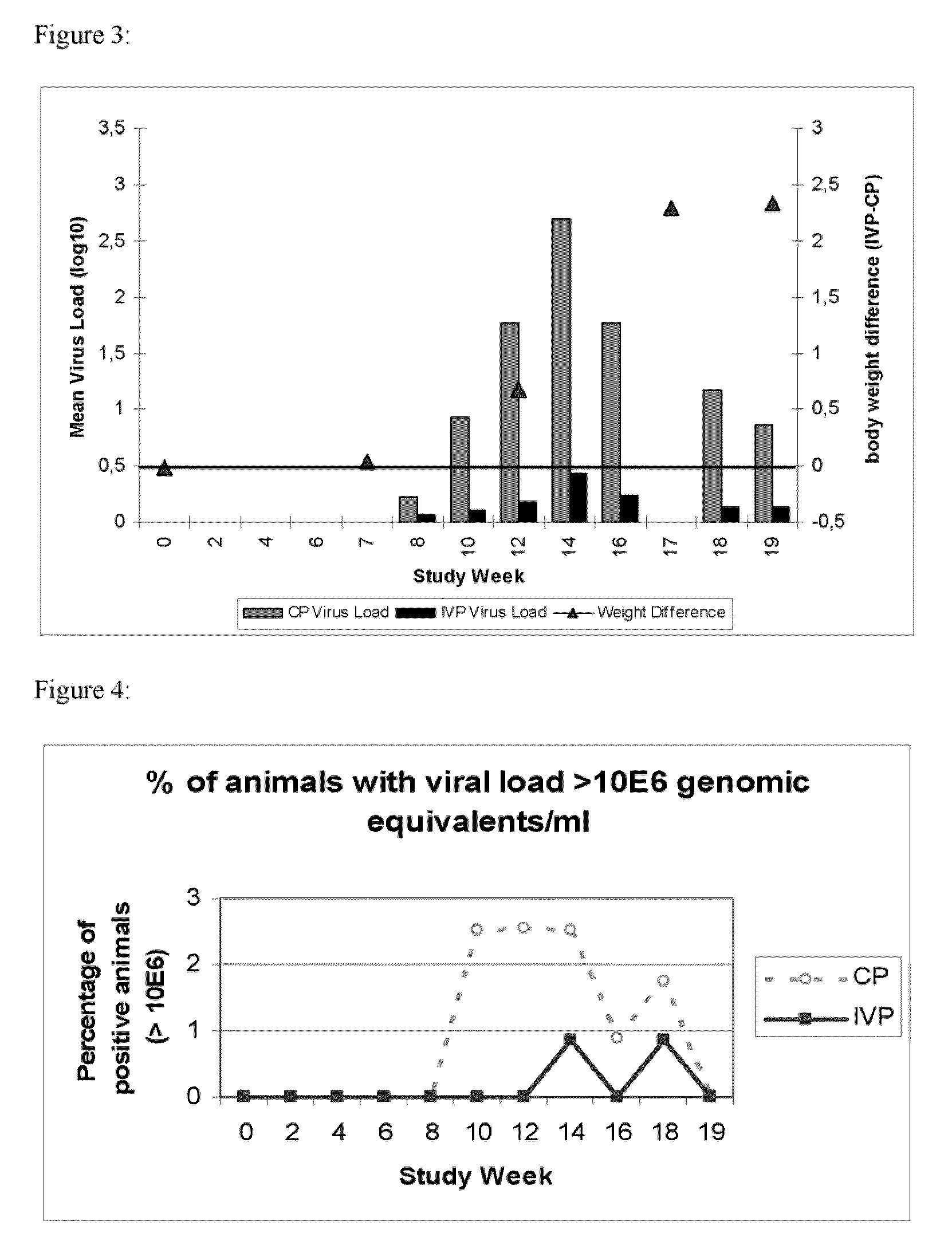Prevention and treatment of sub-clinical PCVD
a sub-clinical pcvd and infection technology, applied in the field of immunogenic diseases, can solve the problems of significant growth impairment including weight gain loss, and no evidence is given in the prior art so far that sub-clinical pcv2 infections have any impact on health
- Summary
- Abstract
- Description
- Claims
- Application Information
AI Technical Summary
Problems solved by technology
Method used
Image
Examples
example 1
Preparation of PCV2 ORF-2 Antigen
[0109]Initial SF+ cell cultures from liquid nitrogen storage were grown in Excell 420 media (JRH Biosciences, Inc., Lenexa, Kans.) in suspension in sterile spinner flasks with constant agitation. The cultures were grown in 100 mL to 250 mL spinner flasks with 25 to 150 mL of Excell 420 serum-free media. When the cells had multiplied to a cell density of 1.0-8.0×106 cells / mL, they were split to new vessels with a planting density of 0.5-1.5×106 cells / mL. Subsequent expansion cultures were grown in spinner flasks up to 36 liters in size or in stainless steel bioreactors of up to 300 liters for a period of 2-7 days at 25-29° C.
[0110]After seeding, the flasks were incubated at 27° C. for four hours. Subsequently, each flask was seeded with a recombinant baculovirus containing the PCV2 ORF-2 gene (SEQ ID NO: 4). The recombinant baculovirus containing the PCV2 ORF-2 gene was generated as described in WO06 / 072065. After being seeded with the baculovirus, th...
example 2
Anti PCV-2 Immuno Assay
[0112]PK15 (e.g. ATCC CCL-33) or VIDO R1 cells described in WO 02 / 07721, are seeded onto a 96 well plate (about 20.000 to 60.000 cells per wells). Cells are infected with a PCV2 isolate, when monolayers are approximately 65 to 85% confluent. Infected cells are incubated for 48 hours. Medium is removed and wells are washed 2 times with PBS. The wash buffer is discarded and cells are treated with cold 50 / 50 methanol / acetone fixative (˜100 μl / well) for about 15 min at about −20° C. The fixative is discarded and the plates are air tried. Serial dilutions of porcine serum samples are prepared in PBS, added to the plates and incubated to allow antibodies to bind if present in the serum samples for about 1 hr at 36.5±1° C. In addition, serial dilutions of an anti-PCV2 positive and negative control sample (Positive Control and Negative Control Samples) are run in parallel. The plates are then washed three times with PBS. The PBS is discarded. Plates are then stained w...
example 3
Efficacy of PCV2 ORF-2 (Ingelvac® CircoFLEX™) in Treatment of Chronic PCV2 Infection
Study Objective and Design
[0113]Conventional piglets from five consecutive week groups, each comprising approximately 300 animals were included into this study. Animals were equally distributed among two treatment groups with respect to initial body weight and litter assignment. At the day of weaning, one group (n=775) was vaccinated with Ingelvac® CircoFLEX, containing the minimum release antigen content and the other group of piglets (n=773) received control product (physiological saline). The vaccine and the control product (CP) were given as a single 1 ml dose intramuscularly in the right neck region when piglets were approx. 21 days old. Individual live body weights of all study animals were collected. Clinical observations with respect to PCV2 associated symptoms were performed and deviations from normal general health were recorded on an individual animal basis.
[0114]Serum samples and nasal se...
PUM
| Property | Measurement | Unit |
|---|---|---|
| weight | aaaaa | aaaaa |
| diameter | aaaaa | aaaaa |
| weight | aaaaa | aaaaa |
Abstract
Description
Claims
Application Information
 Login to View More
Login to View More - R&D
- Intellectual Property
- Life Sciences
- Materials
- Tech Scout
- Unparalleled Data Quality
- Higher Quality Content
- 60% Fewer Hallucinations
Browse by: Latest US Patents, China's latest patents, Technical Efficacy Thesaurus, Application Domain, Technology Topic, Popular Technical Reports.
© 2025 PatSnap. All rights reserved.Legal|Privacy policy|Modern Slavery Act Transparency Statement|Sitemap|About US| Contact US: help@patsnap.com



